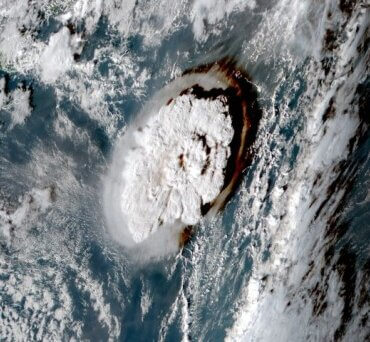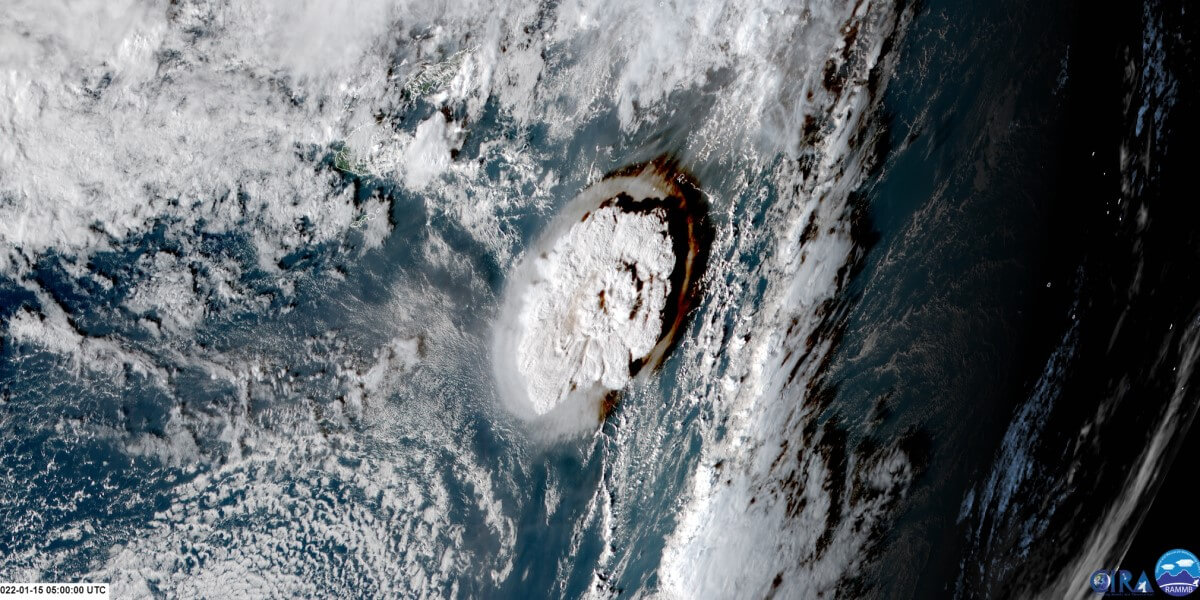
Hunga Tonga–Hunga Ha’apai eruption in Tonga
As we move through our days, much of our experience comes from different forms of energy, carried by waves. We detect light with our eyes, temperature with our skin, and sound with our ears. Sound is simply vibration that travels through air, water, or objects as an acoustic wave, or at least the portion that we can hear.

Janine Krippner
Listening gives us a rich tapestry of information about our surroundings. Do we hear another person? Animals? Traffic? Music? As someone who has music playing almost constantly, this is something I especially appreciate.
As a volcanologist, I also appreciate sound waves in a very different way. When volcanoes erupt they produce a wide range of noises, including some that our ears cannot detect. Acoustic waves below human hearing are called infrasound, defined as low-frequency waves under 20 hertz (Hz). Humans generally hear in the 20–20,000 Hz range, so infrasound is literally below our perception. These waves are tiny fluctuations in atmospheric pressure that can travel great distances from their source and be recorded by instruments.
Infrasound monitoring is similar in concept to seismic monitoring. Seismometers measure energy waves moving through the ground, while infrasound sensors detect waves moving through the air. Just as a network of seismometers across a broad area can be used to locate an earthquake, an array of infrasound sensors can pinpoint where an explosion or eruption has occurred.
This technology is not limited to volcanoes. The Comprehensive Nuclear-Test-Ban Treaty Organization operates a global infrasound network to monitor for nuclear weapons testing. The same system also detects large volcanic eruptions, meteor airbursts, and other processes in our atmosphere. One striking example was the January 2022 eruption of Hunga Tonga–Hunga Ha’apai, one of the most powerful explosions in recent times. Some of its pressure waves circled the globe multiple times.
A challenge is that many things produce infrasound, from storms to ocean waves. Geophysicists carefully filter out this background “noise” to extract useful information about volcanic processes. Some have even described volcanoes as musical instruments.
There is even an interesting area of research where infrasound is used to study the sounds that animals, such as elephants, make. Unlike our voices, which fade away quickly, these low-frequency sounds can travel across many kilometres, making them a powerful tool for communication.
Herein lies one of the greatest advantages of infrasound monitoring – its ability to detect activity at great distances. Remote volcanoes, such as those in Alaska’s Aleutian Islands, may be thousands of kilometres from population centres but still pose a hazard to aircraft. Infrasound data can confirm eruptions and help classify whether they are producing ash plumes that may be a danger to aircraft.
Whether erupting or quiet, using a range of monitoring techniques including seismology, gas measurements, ground deformation, and satellites, can help us to get a clearer image of what is happening at and below volcanoes. Infrasound is one more way of “listening” to the Earth, adding to our understanding of the complex processes at work. The more perspectives we use, the better prepared we are to warn those who might be impacted.

Hunga Tonga–Hunga Ha’apai eruption in Tonga








